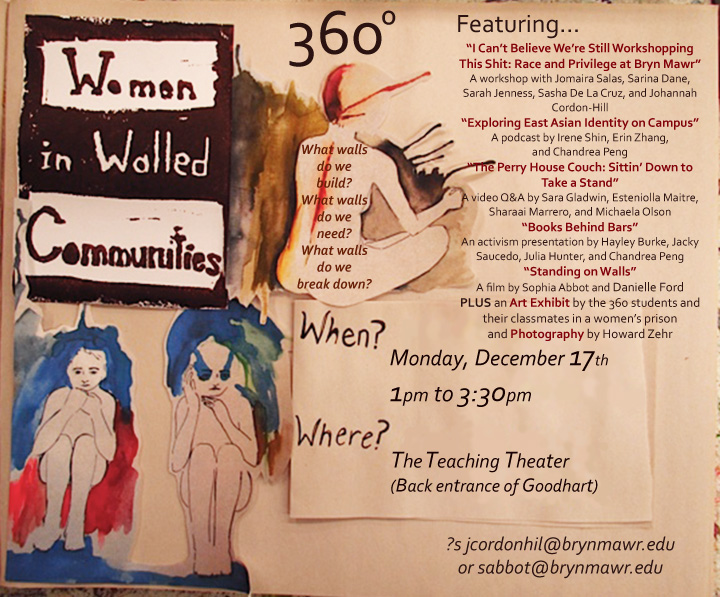Serendip is an independent site partnering with faculty at multiple colleges and universities around the world. Happy exploring!
Anne Dalke's blog

Anne's Reading Notes
Anne’s Reading Notes for Re-creating Our World: Vision, Voice, Value, Spring 2014
on-line materials the 360 planning group discussed in August 2013:

"far from the tree"
i just finished reading andrew solomon's astonishingly big book, far from the tree, and was particularly interested in a chapter about juvenile criminals that focuses a lot on Hennepin County Home School in Minnesota. one inmate complained, "they want you to think all day. I'd rather be breaking up rocks or shit." there were two other passages in that chapter that i want to share (meaning, of course, that i'd be interested in discussing them!) with you all:
"The relationship between kids in the justice system and their parents usually follows one of four tracks. The parents may abandon the child when he goes to prison, which may lead the child to feel lonely, lost, isolated, an desperate. The parents may abandon the child, which may prompt the child to take responsibility for himself or herself. The parents may remain or become deeply involved with the child, making the child feel that a bright future is possible. The parents may remain or become deeply involved with the child, reinforcing antisocil behavior by creating a permissive atmosphere of denial."

Expected Supreme Court ruling...
InClass/OutClassed arrives this week @ the Supreme Court:
http://www.nytimes.com/2013/03/10/sunday-review/the-liberals-against-affirmative-action.html
"elite public and private colleges remain dominated by affluent students. Some colleges probably have more students from the top 2 percent of the income distribution than the bottom 50 percent....Racial discrimination obviously continues to exist. But the disadvantages of class, by most measures, are larger today. A class-based system would be more expensive, forcing colleges to devote some money now spent on buildings and other items to financial aid instead, but it would also arguably be more meritocratic."
...I am hearing echoes, this Sunday morning, of our conversations together 3 semesters ago..

Pull of Gravity: What Happens When They Come Home?
Dear women, now unwalled--
I realize that you are on spring break, so unlikely to be around for this event,
but it seemed so relevant to our conversations in-and-about The Cannery (and leaving it),
that I wanted to share. Perhaps you'd like to get hold of the video, if you can't
attend the screening and conversation?
Thinking of you all,
always,
Anne
Please join us on 3/14/13 at the Fitts Auditorium at UPenn Law School at 5:30 p.m. for a
Screening of this Amazing Philadelphia Documentary, Pull of Gravity:
http://www.pullofgravityfilm.com/
700,000 Inmates are Released Each Year in the U.S.
What Happens When They Come Home?
The film will be followed by a panel discussion with the Directors of the film, the Participants in the film, United States Magistrate Judge Timothy Rice (from federal reentry court), the US Attorney for the Easter District of Pennsylvania Zane Memeger and Professor Regina Austin of Penn Law School.
This is free and open to the public. The last two showings have sold out, so please go to www.pullofgravityfilm.com to reserve your tickets (for free).
Sponsored by the Women's Legal Assistance Project, the Prisoners Education and Advocacy Project and the Criminal Record Expungement Project

Walled Communities in Europe
 |
As some of you know, I was traveling in Northern Europe for a couple of weeks in late January and early February. I came upon a couple of walled communities which (of course!) made me think of you all. In Bruges, Belgium, I spent a peaceful morning in a begijnhof (or beguinage), dating from the 13th century, which once housed a Catholic order of single and widowed women, and today is home to Benedictine nuns:
 |
 |
 |
 |
And then, Normandy, I visited the astonishing abbey on Mont St Michel, an island fortress with a cloister strangely reminiscent of--yet different from--Bryn Mawr's:

How an East Coast geological feature drove the course of the Civil War.
This put me in mind of what Prof. Crawford told us about the
effect of the fault line on the building of cities:
http://opinionator.blogs.nytimes.com/2013/01/16/the-fall-lines-fault/

What Walls Do We Build/Need/Break Down?--Our Final Presentations!

Welcome everybody! We're happy that you’ve joined us here to see what we've learned in our 360° this semester. A 360° is a cluster of interdisciplinary courses that look at one main theme. Ours is called Women in Walled Communities.
In The Rhetorics of Silence, we examined the many functions and meanings of silence: as a political tool, an imaginative space, and a powerful form of communicative expression--as well as the result of lack of agency and or the denial of voice.
In Learning in Institutional Spaces, we explored how the institutions of schools and prisons promote or inhibit learning. It was in this course that we looked most critically at this institution, Bryn Mawr College, and its own history of power and oppression, which sparked a lot of interest in Perry House as an embodiment of some of that history.


